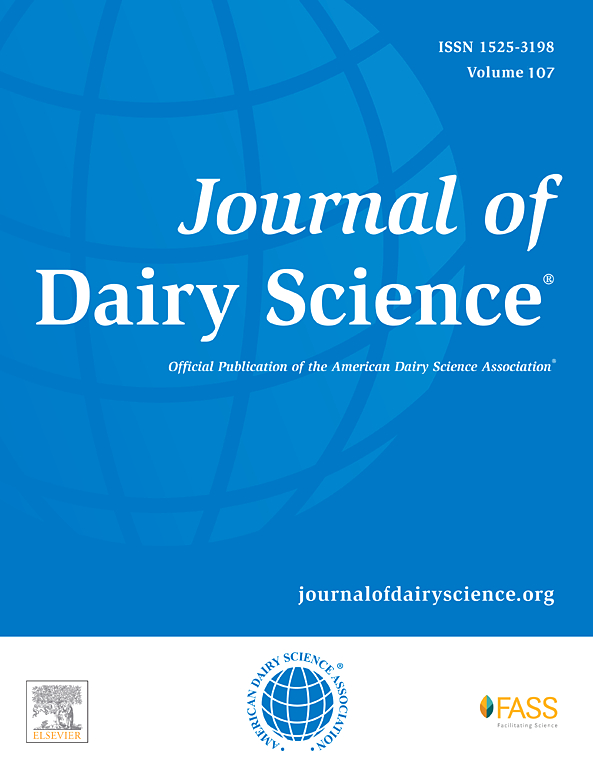Longitudinal characterization of plasma and fecal bile acids in dairy heifers from birth to first calving in response to transition milk feeding
IF 4.4
1区 农林科学
Q1 AGRICULTURE, DAIRY & ANIMAL SCIENCE
引用次数: 0
Abstract
This study aimed to characterize plasma bile acid changes from birth to first calving and evaluate the effects of early transition milk (TM) feeding versus milk replacer (MR) during key stages. Fecal bile acids in TM-fed calves were also analyzed, offering insights into bile acid metabolism. Thirty female Holstein calves were fed TM or MR for the first 5 d, followed by 12 L/d MR. From d 14, calves were fed MR and starter with gradual weaning between wk 8 and 14. Blood samples were collected at 7 time points: 30 min and 12 h after birth, preweaning (wk 2, 6), weaning (wk 14), 8 mo, 13 mo, 3 wk before calving, at calving, and 3 wk after calving. Fecal samples were collected from a subset of TM-fed calves (n = 10) at birth, wk 6, wk 14, 8 mo, and calving. Samples were analyzed for bile acids using the Biocrates MxP Quant 500 kit. Cholic acid (CA) in plasma showed significant time-treatment interactions, with higher levels in TM-fed calves at weaning. Taurine- and glycine-conjugated bile acids had no treatment or time-treatment interactions, but all plasma bile acids showed significant time effects. Principal component analysis revealed that bile acid profiles at birth and after colostrum intake were tightly clustered. Plasma bile acid profiles showed greater dispersion during milk feeding and weaning, with tighter clustering observed postweaning, particularly at 13 mo, and in the transition period. Significant effects were observed for CA, deoxycholic acid (DCA) and chenodeoxycholic acid (CDCA), with CA showing a notable interaction and being higher in TM-fed calves at weaning than in MR-fed calves. Bile acid levels increased toward weaning, peaked at wk 14, and decreased after weaning. Glycine-conjugated bile acids changed over time, with glycocholic acid (GCA) and glycodeoxycholic acid (GDCA) peaking at weaning, and glycochenodeoxycholic acid (GCDCA) being elevated before weaning, decreasing thereafter, and increasing again at calving. Taurine-conjugated bile acids also showed temporal changes, peaking at wk 6. The shifts in bile acid composition from birth to postcalving, with taurolithocholic acid (TLCA), GDCA, and taurocholic acid (TCA) initially dominating, CA increasing at weaning, and GDCA and DCA dominating at calving, with CA increasing again postcalving. During the transition to calving, CA decreased whereas glycine-conjugated bile acids increased relative to taurine-conjugated bile acids in plasma, irrespective of treatment. Fecal bile acid profiles in TM-fed calves clustered distinctly at birth, evolving through pre- to postweaning and calving, with increasing profile overlap over time. Most fecal bile acids, except DCA and CA, were abundant at birth but declined over time. Both DCA and CA increased postweaning, mirroring plasma trends. From wk 6 to calving, DCA was the dominant bile acid, accounting for the highest percentage of total bile acids excreted in feces. Spearman's correlation analysis was performed to assess the relationship between plasma and fecal bile acids in TN-fed calves. A significant positive correlation was observed only for GCDCA (Spearman's rank correlation coefficient [rho] = 0.35), whereas all other bile acids were not correlated. These results illustrate the complex dynamics of bile acid profiles during calf development.
乳母牛从出生到第一次产犊对过渡乳喂养反应的血浆和粪便胆汁酸的纵向特征
本研究旨在描述从出生到第一次产犊的血浆胆汁酸变化,并评估在关键阶段早期过渡乳(TM)喂养与代乳(MR)喂养的影响。还分析了tm喂养小牛的粪便胆汁酸,为胆汁酸代谢提供了见解。30头母荷斯坦犊牛前5 d分别饲喂TM或MR,随后饲喂12 L/d MR,从第14 d开始,分别饲喂MR和发菜,第8 ~ 14周逐渐断奶。在7个时间点采集血样:出生后30分钟和12小时、断奶前(第2、6周)、断奶前(第14周)、8个月、13个月、产犊前3周、产犊时和产犊后3周。在出生、第6周、第14周、第8个月和产犊时收集tm喂养的犊牛(n = 10)的粪便样本。使用Biocrates MxP Quant 500试剂盒分析样品的胆汁酸。血浆中胆酸(CA)表现出显著的时间处理相互作用,断奶时tm喂养的犊牛胆酸水平较高。牛磺酸和甘氨酸偶联胆汁酸没有治疗或时间相互作用,但所有血浆胆汁酸均表现出显著的时间效应。主成分分析显示,出生时和初乳摄入后的胆汁酸谱紧密聚集。血浆胆汁酸分布在喂奶和断奶期间显示出更大的分散,在断奶后观察到更紧密的聚集,特别是在13个月时和过渡时期。CA、去氧胆酸(DCA)和鹅去氧胆酸(CDCA)对断奶犊牛有显著影响,其中CA表现出显著的交互作用,断奶时tm喂养犊牛的CA高于mr喂养犊牛。胆汁酸水平在断奶前升高,在第14周达到峰值,在断奶后下降。甘氨酸偶联胆汁酸随时间变化,糖胆酸(GCA)和糖去氧胆酸(GDCA)在断奶时达到峰值,糖去氧胆酸(GCDCA)在断奶前升高,此后下降,在产犊时再次升高。牛磺酸偶联胆汁酸也表现出时间变化,在第6周达到峰值。从出生到产犊后,胆汁酸组成的变化,最初以牛磺酸胆酸(TLCA)、GDCA和牛磺酸胆酸(TCA)为主,断奶时CA增加,产犊时GDCA和DCA占主导地位,产犊后CA再次增加。在过渡到产犊期间,血浆中甘氨酸共轭胆汁酸相对于牛磺酸共轭胆汁酸升高,而甘氨酸共轭胆汁酸相对于牛磺酸共轭胆汁酸升高。tm喂养小牛的粪胆汁酸谱在出生时明显聚集,在断奶前到断奶后和产犊期间不断进化,随着时间的推移,谱重叠越来越多。除DCA和CA外,大多数粪便胆汁酸在出生时含量丰富,但随着时间的推移而下降。DCA和CA均在断奶后增加,反映了血浆趋势。从第6周至产犊,DCA为优势胆汁酸,占粪便中总胆汁酸的最高百分比。采用Spearman相关分析来评估tn喂养犊牛血浆与粪便胆汁酸之间的关系。仅GCDCA存在显著正相关(Spearman等级相关系数[rho] = 0.35),其他胆汁酸均不相关。这些结果说明了犊牛发育过程中胆汁酸谱的复杂动态。
本文章由计算机程序翻译,如有差异,请以英文原文为准。
求助全文
约1分钟内获得全文
求助全文
来源期刊

Journal of Dairy Science
农林科学-奶制品与动物科学
CiteScore
7.90
自引率
17.10%
发文量
784
审稿时长
4.2 months
期刊介绍:
The official journal of the American Dairy Science Association®, Journal of Dairy Science® (JDS) is the leading peer-reviewed general dairy research journal in the world. JDS readers represent education, industry, and government agencies in more than 70 countries with interests in biochemistry, breeding, economics, engineering, environment, food science, genetics, microbiology, nutrition, pathology, physiology, processing, public health, quality assurance, and sanitation.
 求助内容:
求助内容: 应助结果提醒方式:
应助结果提醒方式:


